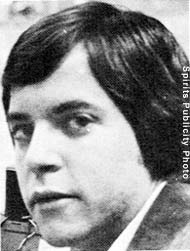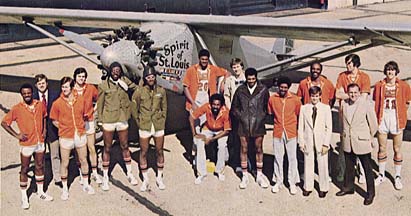Brett: I really appreciate all the work you do. I'm writing a story for our publication that's going to be coming out in a couple weeks that's taking a little twist on the ABA story. It looks a little bit less at the anecdotal aspect of the league. I’ve seen and have read a lot of the stories that you’ve told about the time, but I’m trying to take a little different twist in terms of your impressions of the ABA, comparing the impact it made then, and on today’s game.
Bob: When I first came to St. Louis to broadcast ABA games, honestly, my greatest excitement was to get a job at KMOX, because I’d listened to the Cardinals with Harry Caray and Jack Buck, and to the Hawks, with Buddy Blatner and Jerry Gross doing the games, ‘cause I could pick KMOX up on Long Island where I grew up. On a clear night you could get it. To me, it was the idea of being in a big city like St. Louis, and at a great, legendary station like KMOX. The ABA and the Spirits were secondary at the beginning. And in fact, as a lifelong NBA guy, I carried the stereotype into the ABA that the league was inferior and that I wouldn't see anything, besides maybe Dr. J,, that would be worth writing home about. And I was wrong.
The league, with the exception of Artis Gilmore, didn’t have the truly first-rate centers. Even a guy like Mel Daniels, who was a terrific player, he’d be a forward in an ideal situation. Or else they imported NBA guys toward the end, like Zelmo Beaty. With the exception of that, toward the end -- and my experience in the league was only the last two years, that’s the two years the Spirits existed, ‘74-‘76 -- if you took the five best guards in the league and the five best forwards in the league, it would have matched up pretty favorably with what the NBA had to offer.
I started saying this a long time ago, I said it right away in ’77, and Terry Pluto later used it in his book, and HBO used it on their special awhile ago: 10 of the 24 players in the All-Star Game the first year after the merger either came out of the ABA or had, like Billy Cunningham and Rick Barry, gone through the ABA, been in the ABA. And five of the ten starters in the finals were ABA players, when Portland played Philadelphia.
So what did you think at the time were the most significant contributions the ABA was making to professional basketball in general?
I thought the most significant contribution -- and Dr. J epitomized this more than anybody else -- was to legitimize flamboyance, that flamboyance and selfishness were not synonymous. That you could flash style and still be a team player, that you could entertain and still play the game in a way that deserved respect, that button-down was not the only way to play.
That's for sure.
Now this has been distorted and perverted, almost, in modern basketball. You had in the ABA guys who entertained, and guys who liked to entertain, but you didn't see that in-you-face belligerence that’s everywhere in basketball today.
Yeah, I was going to ask how does that translate, the impact the ABA had 20-30 years ago on today’s NBA?
I don’t think today’s NBA has anything to do with the ABA. I think it’s just an outgrowth of what basketball in general has become, because the NBA has long since absorbed anything worthwhile about the ABA. The 3-point shot, the idea that the game could be wide-open and fun as well as fundamentally sound -- that there was no contradiction between good basketball and entertainment and flamboyance.
Now, by the way, the ABA did not invent that, the Knicks of the early 70’s were very entertaining to watch for a different reason, and Pete Maravich and Earl "the Pearl" Monroe were doing magical things in the NBA…
Oh, definitely, yeah.
…as Elgin Baylor had. And the Celtics ran a fast break that I always found entertaining as a kid. So, the idea is that, it wasn’t a bunch of guys just standing around throwing bounce passes while James Naismith watched.
And peach baskets…
Right. So I mean, it’s not like the ABA necessarily invented this stuff, but it was more that overall, what existed in pockets of the NBA was more the overall style of the ABA.
What would you have pulled out at the time for you -- aside from just the thrill of broadcasting at a station you’ve long listened to as a child -- what was the appeal for you of the ABA at the time? What really grabbed you?
The wide-open style of play, and the fact that we had in the league so many good players, more than the general public realized. I mean, Marvin Barnes -- with the exception of Bill Walton, Marvin Barnes was the best player to come out of college at the time. Had Marvin Barnes stayed straight, he definitely would have been among those 50 players standing up in Cleveland as one of the 50 greatest of all time a couple years ago.
Moses Malone was in the ABA, Dr. J, George McGinnis, Dan Issel. And then guys whose careers were more or less ending, who had been really good players: Roger Brown, and James Silas, who blew his knee out just about the time of the merger, was a tremendous guard. George Gervin, didn’t George Gervin lead the NBA in scoring?
Sure he did…
And remember, at the end of the ABA there were only seven teams. At the beginning of the last season I guess there were nine or ten, so this was a very high concentration of very good players.
There is a resurgence -- I mean, you see more and more articles, the HBO special you mentioned -- what do you think…I mean, for example, myself, I look at the ABA as and have seen it described as "the last great hidden league." My basketball following came when Gilmore came to the Bulls in ‘76-’77, that’s when I really started to pick it up. I missed the ABA, I never got to see it, and even so, growing up in Chicago, I would have had very, very little exposure to it. Why do we find, do you think, just as basketball fans, what makes the ABA such a compelling story?
I think part of the reason is, two things kind of pushed it: Pluto’s book and the HBO special pushed it back into people’s consciousness.
Uncovered it for people…
Yeah. The thing that’s fascinating, though, is that it’s a league of fairly recent vintage. I mean, modern basketball fans certainly remember Dr. J playing for the 76ers, and they remember Moses Malone, who played until a few years ago. So the connections are fairly recent. But because it had no national television contract, it’s just about the last major sports undertaking that where most of what we know about it is by word of mouth. It’s by anecdote.
It almost seemed…for example, what Mark McGwire did last year was phenomenal, but everyone saw it and it’s been replayed so many times that there’s no room for personal interpretation. What fascinated about DiMaggio was that you had a few pictures of him, a few grainy little black-and-white things and mostly it was somebody’s story of what it felt like to watch DiMaggio play center field. Now that would have been in the 1940s. Here we are in the 1970s, and most of what we know about the ABA is a story that somebody who was there could tell you about a play that Dr. J made on a Tuesday night in Louisville. That distance, that mystery, is so different from almost everything else in an oversaturated sports world, that that’s what makes it fascinating.
What’s intriguing to me is that it’s so hard to find even still photos, much less, you know, broadcast tape of games. The publication that this used to be, Basketball Weekly, actually gave fairly equal -- nearly 50% coverage -- it started about the same time as the ABA did, and gave a lot of coverage to it.
Jim O’Brien was the regular ABA columnist, out of Pittsburgh. I remember that, because we used to read it. Everyone used to have Basketball Weekly on the planes, and traveling with the team, because it did give the ABA a fair shake.
A big picture question to wrap up. What would you consider -- obviously you’re very, very close to it -- the state of professional basketball today?
Today? Well, through the marketing and through the high-profile championship performances of the most appealing players of the last two decades -- Dr. J was at the beginning of it, but Magic and Larry and Michael, through all those things, it rose to a tremendous level.
I think there has to be some concern now about the overall quality of play. The league has expanded now, and I don’t know what all the factors are, but generally speaking, the average NBA game is not as appealing in the late 90’s as it was in the mid-to-late 80’s. And you have to wonder is there anybody that will be as universally popular as a Johnson, a Bird, a Dr. J, a Michael Jordan -- not just be as universally popular and accomplished as a player, but be on a team that will always contend for the championship so that they get to center stage. That’s always something that’s overlooked during the NBA’s great period of popularity, that the best-known and most popular players were always in the finals.
Just looking at this season, it’s a crapshoot, basically anybody could win…
Yeah.
…you get a team that’s hot like Charlotte, jeez, they could end up winning it somehow.
Thanks a lot, Bob.
OK, you’re welcome. Nice talking with you.

